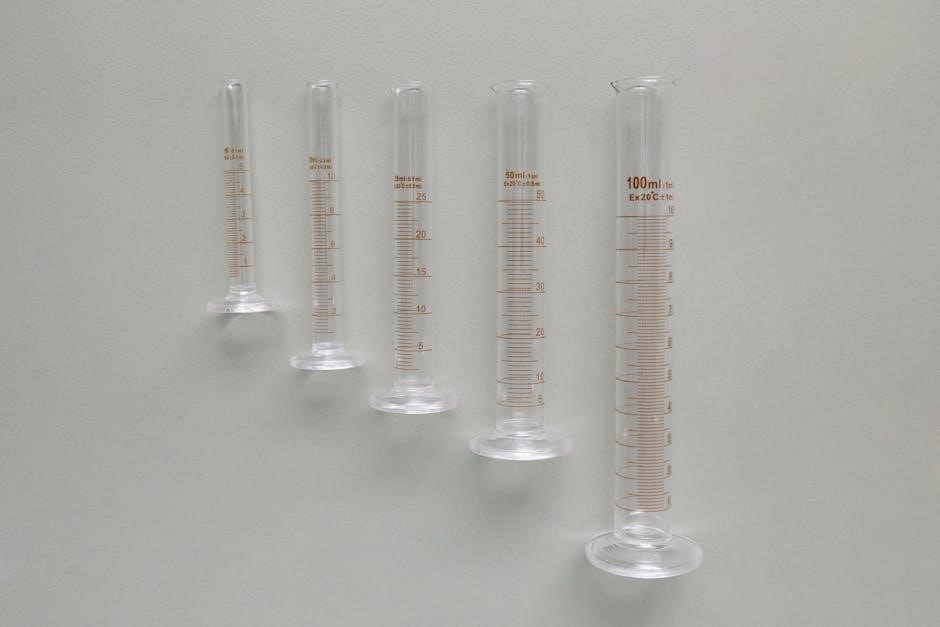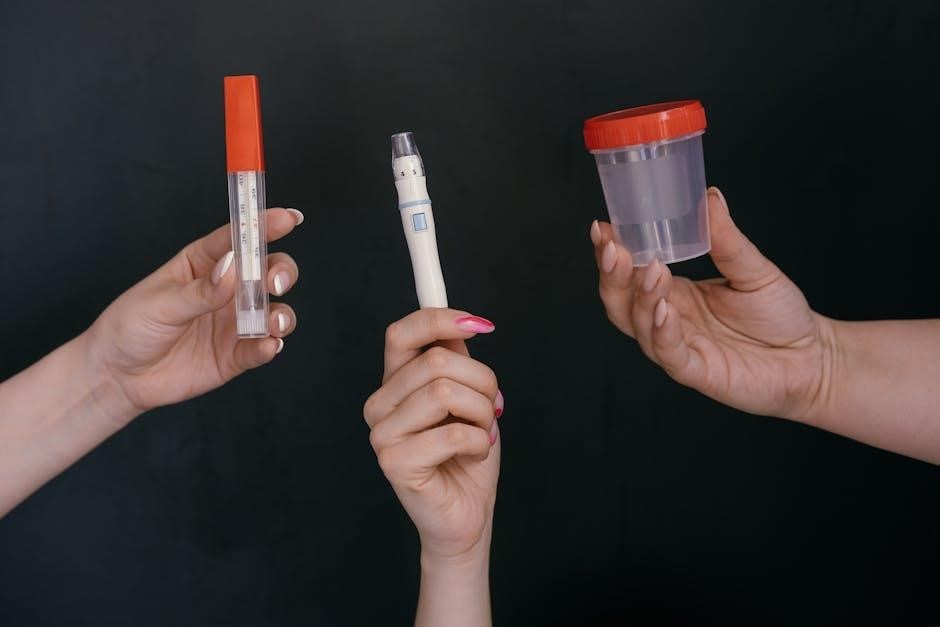Lab values are essential for diagnosing and monitoring patient conditions. Nurses must understand normal ranges to interpret results accurately. This guide provides a comprehensive overview of key lab tests.
1.1 Importance of Lab Values in Nursing Practice
Lab values are crucial for assessing patient health and guiding clinical decisions. Nurses rely on these values to diagnose conditions, monitor treatment effectiveness, and identify potential complications early. Accurate interpretation ensures safe, evidence-based care. Lab results, such as blood gases, electrolytes, and hematology tests, provide insights into physiological and pathological states. Understanding normal ranges helps nurses recognize abnormalities, enabling timely interventions. This knowledge is vital for maintaining patient safety and improving outcomes. By integrating lab data with clinical symptoms, nurses can deliver personalized, effective care tailored to individual needs.
1.2 Overview of Common Lab Tests for Nurses
Nurses frequently encounter lab tests like complete blood counts, electrolyte panels, and urinalyses. These tests provide critical data on a patient’s health status. Hematology tests, such as RBC and WBC counts, assess blood components. Blood chemistry tests measure substances like glucose, BUN, and creatinine to evaluate organ function. Arterial blood gases (ABGs) help assess respiratory and acid-base balance. Urinalyses detect abnormalities like protein or blood in urine. Understanding these common tests is vital for monitoring disease progression and guiding treatment. Familiarity with normal ranges enables nurses to identify deviations and prioritize care. These tests are foundational for delivering evidence-based nursing practice and ensuring patient safety.

Hematology Lab Values
Hematology lab values assess blood components, including RBC, WBC, and platelet counts. These tests are crucial for diagnosing anemia, infections, and bleeding disorders. Normal ranges vary by age and gender.
2.1 Red Blood Cell (RBC) Count and Normal Ranges
The Red Blood Cell (RBC) count measures the number of red blood cells in the blood, essential for oxygen transport. Normal RBC ranges vary by age and gender. For adult males, it is typically 4.2-5.6 million cells/μL, while for adult females, it is 3.8-5.1 million cells/μL. Children and infants have slightly lower ranges. Abnormal RBC counts can indicate anemia (low) or conditions like polycythemia (high). Nurses must interpret these values to identify potential health issues, such as nutrient deficiencies or chronic diseases. Accurate RBC count interpretation is vital for diagnosing and managing patient care effectively.
2.2 White Blood Cell (WBC) Count and Interpretation
The White Blood Cell (WBC) count measures the body’s immune response. Normal WBC ranges for adults typically fall between 3,800 to 10,800 cells/μL. Elevated levels may indicate infection, inflammation, or leukemia, while low levels can signal immunodeficiency or bone marrow suppression. Nurses interpreting WBC counts must consider the patient’s clinical context, such as symptoms of infection or recent treatments. Accurate interpretation aids in timely interventions, such as administering antibiotics or further diagnostic testing. Understanding WBC trends over time is crucial for monitoring the effectiveness of treatments and patient recovery. This makes WBC count a vital component of nursing assessment and care planning.
2.3 Platelet Count and Clinical Significance
The platelet count measures the number of platelets in the blood, essential for clotting. Normal ranges are 150,000 to 450,000/μL; Low platelets (thrombocytopenia) increase bleeding risk, while high levels (thrombocythemia) may indicate clotting disorders. Causes of abnormal counts include infections, medications, or bone marrow issues. Nurses should monitor for signs of bleeding or clotting and handle blood samples carefully to avoid errors. Accurate interpretation of platelet counts aids in preventing complications and guiding therapies, such as transfusions or medications. This makes platelet count a critical marker for assessing hematologic health and ensuring patient safety in clinical settings.
Blood Chemistry Lab Values
Blood chemistry tests assess organ function and electrolyte balance; Key tests include electrolytes, kidney function, and liver enzymes. These values guide diagnosis and treatment plans.

3.1 Electrolytes: Sodium, Potassium, and Chloride Levels
Sodium, potassium, and chloride are critical electrolytes. Sodium levels range from 135-145 mEq/L, while potassium ranges from 3.5-5.3 mEq/L. Chloride levels are typically between 96-106 mEq/L. These electrolytes regulate fluid balance and nerve function. Abnormal levels can indicate dehydration, kidney issues, or acid-base imbalances. Nurses must monitor these values to provide appropriate interventions, such as fluid replacement or dietary adjustments. Understanding normal ranges ensures accurate assessment and effective care planning for patients with electrolyte imbalances.

3.2 Kidney Function Tests: BUN and Creatinine
Blood urea nitrogen (BUN) and creatinine are key indicators of kidney function. BUN levels normally range from 8-23 mg/dL, while creatinine levels are typically 0.6-1.2 mg/dL for males and 0.5-1.1 mg/dL for females. Elevated BUN may indicate dehydration or kidney disease, while high creatinine suggests impaired renal function. Nurses monitor these values to assess hydration status and renal health, guiding interventions like fluid management or further diagnostic testing. Accurate interpretation of BUN and creatinine levels is crucial for ensuring optimal patient outcomes and timely treatment of kidney-related issues.
3.3 Liver Function Tests: ALT, AST, and Bilirubin
Liver function tests, including alanine aminotransferase (ALT), aspartate aminotransferase (AST), and bilirubin, are crucial for assessing hepatic health. ALT levels normally range from 0-40 U/L, while AST ranges from 0-48 U/L. Elevated levels may indicate liver damage or disease. Bilirubin, which measures liver excretion, has a normal range of 0.3-1.2 mg/dL for direct and 0.5-1.5 mg/dL for total. High bilirubin levels can lead to jaundice. Nurses monitor these values to identify potential liver dysfunction, guide treatment, and assess disease progression; Accurate interpretation of these tests is vital for providing targeted care and improving patient outcomes.

Arterial Blood Gas (ABG) Values
ABG values assess oxygenation, ventilation, and acid-base balance. Normal ranges include pH (7.35-7.45), PaCO2 (35-45 mmHg), and PaO2 (75-100 mmHg). HCO3 levels typically range from 22-26 mEq/L.
4.1 Normal pH and PaCO2 Levels
Normal pH levels in arterial blood range from 7.35 to 7.45, indicating slight alkalinity. PaCO2 levels, measuring carbon dioxide, typically fall between 35-45 mmHg. These values reflect proper respiratory function and acid-base balance. Elevated PaCO2 suggests respiratory acidosis, while decreased levels indicate alkalosis. Nurses must monitor these values to assess ventilation and overall respiratory health, ensuring timely interventions for abnormalities. Understanding these norms is crucial for interpreting ABG results and guiding patient care effectively.
4.2 Oxygen Levels: PaO2 and SaO2
Normal PaO2 levels range from 75 to 100 mmHg, reflecting the partial pressure of oxygen in arterial blood. SaO2, or oxygen saturation, typically ranges from 95% to 100%, indicating the percentage of hemoglobin binding oxygen. These values are critical for assessing oxygenation and respiratory function. Low PaO2 or SaO2 may indicate hypoxemia, suggesting conditions like respiratory failure or anemia. Nurses monitor these levels to evaluate the need for oxygen therapy or further interventions. Maintaining normal oxygen levels is vital for ensuring proper tissue perfusion and overall patient health.
4.3 Bicarbonate (HCO3) and Base Excess
Bicarbonate (HCO3) levels typically range from 22 to 26 mEq/L, playing a crucial role in maintaining acid-base balance. Base excess, measured in mEq/L, normally ranges from -2 to +2. These values reflect the body’s buffering capacity against acid-base disturbances. Elevated HCO3 levels may indicate metabolic alkalosis, while low levels suggest acidosis. Base excess helps assess the severity of acid-base imbalances, guiding interventions like fluid or electrolyte adjustments. Nurses must interpret these values alongside other ABG results to identify trends and monitor respiratory or metabolic conditions effectively. Accurate interpretation ensures timely interventions to restore balance and improve patient outcomes.

Urinalysis Lab Values
Urinalysis assesses kidney function and detects abnormalities. Key components include specific gravity, pH, protein, glucose, ketones, and presence of blood or leukocyte esterase. Normal ranges guide patient assessment.
5.1 Specific Gravity and pH of Urine
Specific gravity measures urine concentration, ranging from 1.001 to 1.035, reflecting hydration status. Normal urine pH ranges from 4.6 to 8.0, indicating acid-base balance. Abnormal values may suggest dehydration, renal issues, or metabolic disturbances. Nurses monitor these to assess fluid status and overall health. Elevated specific gravity suggests dehydration, while low levels indicate overhydration. pH levels outside the normal range can signal conditions like urinary tract infections or metabolic acidosis/alkalosis. Accurate measurement and interpretation are crucial for timely interventions, such as fluid management or further diagnostic testing. These values are foundational in urinalysis, guiding nursing care and patient outcomes effectively.
5.2 Protein, Glucose, and Ketones in Urine
Normal urine typically contains 0-10 mg/dL of protein, with levels above this indicating potential kidney damage or disease. Glucose is usually absent or present in trace amounts (0-15 mg/dL), as its presence (glycosuria) may suggest uncontrolled diabetes or renal issues. Ketones are also typically absent or found in trace amounts, but elevated levels (ketonuria) can indicate diabetic ketoacidosis or fasting states. Nurses should monitor these values to assess metabolic and renal function. Abnormal findings often prompt further evaluation, such as blood glucose testing or renal assessment, to guide appropriate interventions and ensure patient well-being.
5.3 Blood and Leukocyte Esterase in Urine
In a normal urinalysis, blood is typically absent or present in trace amounts, as its presence (hematuria) may indicate urinary tract infections, kidney stones, or other pathologies. Leukocyte esterase, an enzyme found in white blood cells, is also usually negative. A positive result suggests a potential infection, such as a urinary tract infection (UTI), as it indicates the presence of white blood cells. Nurses should note these findings to identify possible infections or inflammation, guiding further diagnostic steps or treatment. Accurate interpretation of these values is crucial for early detection and management of urinary system disorders in patients.

Nursing Implications and Interpretation
Understanding lab values is crucial for nurses to identify normal versus abnormal results, guiding patient care decisions, and implementing appropriate interventions based on clinical judgment and evidence-based practices.
6.1 Interpreting Abnormal Lab Results
Interpreting abnormal lab results is critical for nurses to identify potential health issues. Abnormal values may indicate underlying conditions such as infections, organ dysfunction, or electrolyte imbalances. For example, elevated WBC counts suggest infection, while low hemoglobin levels may indicate anemia. Nurses must correlate lab findings with clinical symptoms and patient history to provide accurate care. Abnormal results should prompt further investigation or consultation with healthcare providers. Timely interpretation ensures appropriate interventions, improving patient outcomes. Nurses play a key role in monitoring trends and reporting critical changes, making lab interpretation a cornerstone of effective nursing practice and patient care.
6.2 Clinical Correlation of Lab Values

Clinical correlation of lab values involves connecting test results with a patient’s symptoms, medical history, and physical findings. For example, elevated BUN and creatinine levels may indicate kidney dysfunction, especially if accompanied by symptoms like fatigue or edema. Nurses must consider the patient’s overall clinical picture when interpreting labs, as isolated abnormalities can be misleading. Accurate correlation ensures targeted interventions and prevents unnecessary treatments. By integrating lab data with clinical observations, nurses contribute to precise diagnoses and personalized care plans, enhancing patient outcomes and streamlining healthcare delivery.
6.3 Nursing Interventions Based on Lab Findings
Nursing interventions based on lab findings involve tailored actions to address abnormal results and promote patient well-being. For instance, low hemoglobin may require iron supplements or dietary adjustments, while elevated potassium levels necessitate cardiac monitoring and potassium-lowering therapies. Nurses should assess fluid status in patients with electrolyte imbalances and administer IV fluids or diuretics as prescribed. Oxygen therapy may be indicated for low PaO2 levels. Monitoring for signs of complications, such as bleeding in thrombocytopenia, is crucial. Patient education on lifestyle changes, medication adherence, and follow-up care ensures continuity of treatment. Timely interventions improve outcomes and prevent deterioration, emphasizing the role of nurses in patient care.
